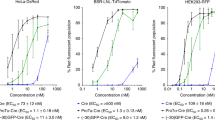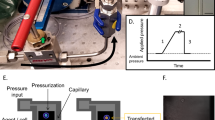Abstract
To date, the primary approach to improve the transfection properties of cationic lipids has been the synthesis of new kinds of cationic amphipaths or the inclusion of noncationic helper lipids. Here, it is reported that an alternative approach can be unusually effective, namely, the combination of two cationic lipid derivatives having the same head group but tails of different chain lengths. Particularly efficient was the combination of dilauroyl (12 carbon chain) and dioleoyl (18 carbon chain) homologues of O-ethylphosphatidylcholine. This mixture transfected DNA into human umbilical artery endothelial cells (HUAEC) more than 30-fold more efficiently than either compound separately. A unique advantage of this kind of combination agent is that transfection can be optimized either in the presence or absence of serum by adjusting the component ratio.
This is a preview of subscription content, access via your institution
Access options
Subscribe to this journal
Receive 12 print issues and online access
$259.00 per year
only $21.58 per issue
Buy this article
- Purchase on Springer Link
- Instant access to full article PDF
Prices may be subject to local taxes which are calculated during checkout





Similar content being viewed by others
References
Koning GA, Schiffelers RM, Storm G . Endothelial cells at inflammatory sites as target for therapeutic intervention. Endothelium 2002; 9: 161–171.
Neuhaus T et al. Tumour necrosis factor-alpha gene expression and production in human umbilical arterial endothelial cells. Clin Sci 2000; 98: 461–470.
Stier S et al. Identification of syntenin and other TNF-inducible genes in human umbilical arterial endothelial cells by suppression subtractive hybridization. FEBS Lett 2000; 467: 299–304.
Behrendt D, Ganz P . Endothelial function. From vascular biology to clinical applications. Am J Cardiol 2002; 90: 40L–48L.
Ulrich-Merzenich G, Metzner C, Schiermeyer B, Vetter H . Vitamin C and vitamin E antagonistically modulate human vascular endothelial and smooth muscle cell DNA synthesis and proliferation. Eur J Nutr 2002; 41: 27–34.
Ellis LM . A targeted approach for antiangiogenic therapy of metastatic human colon cancer. Am Surg 2003; 69: 3–10.
Nam NH, Parang K . Current targets for anticancer drug discovery. Curr Drug Targets 2003; 4: 159–179.
Ranieri G, Gasparini G . Angiogenesis and angiogenesis inhibitors: a new potential anticancer therapeutic strategy. Curr Drug Targets Immune Endocr Metabol Disord 2001; 1: 241–253.
Sylven C . Angiogenic gene therapy. Drugs Today (Barc) 2002; 38: 819–827.
Baker AH . Development and use of gene transfer for treatment of cardiovascular disease. J Card Surg 2002; 17: 543–548.
Morishita R . Recent progress in gene therapy for cardiovascular disease. Circ J 2002; 66: 1077–1086.
Teifel M, Heine LT, Milbredt S, Friedl P . Optimization of transfection of human endothelial cells. Endothelium 1997; 5: 21–35.
MacDonald RC et al. O-ethylphosphatidylcholine: a metabolizable cationic phospholipid which is a serum-compatible DNA transfection agent. J Pharm Sci 1999; 88: 896–904.
MacDonald RC et al. Physical and biological properties of cationic triesters of phosphatidylcholine. Biophys J 1999; 77: 2612–2629.
Xu YH, Szoka FC . Mechanism of DNA release from cationic liposome/DNA complexes used in cell transfection. Biochemistry 1996; 35: 5616–5623.
Struck DK, Hoekstra D, Pagano RE . Use of resonance energy transfer to monitor membrane fusion. Biochemistry 1981; 20: 4093–4099.
Pownall HJ, Bick DLM, Massey JB . Spontaneous phospholipid transfer – development of a quantitative model. Biochemistry 1991; 30: 5696–5700.
Pownall HJ, Hicksonbick D, Massey JB . Effects of hydrophobicity on turnover of plasma high-density-lipoproteins labeled with phosphatidylcholine ethers in the rat. J Lipid Res 1991; 32: 793–800.
Acknowledgements
We thank Yaeko Hiyama (Northwestern University, USA) for synthesizing some of the compounds used in investigating the lipid mixture effects. This study is supported by NIH Grant GM52329.
Author information
Authors and Affiliations
Additional information
The term ‘lipoid’ is more accurate since ‘lipid’ refers to natural products, whereas ‘lipoid’ is used to molecules that are similar to lipids in structure and in properties but not natural products.
Rights and permissions
About this article
Cite this article
Wang, L., MacDonald, R. New strategy for transfection: mixtures of medium-chain and long-chain cationic lipids synergistically enhance transfection. Gene Ther 11, 1358–1362 (2004). https://doi.org/10.1038/sj.gt.3302297
Received:
Accepted:
Published:
Issue Date:
DOI: https://doi.org/10.1038/sj.gt.3302297
Keywords
This article is cited by
-
Delivery into cells: lessons learned from plant and bacterial toxins
Gene Therapy (2005)



